
Editor's note
The ProtectiveClean 4100 is being discontinued. It has been replaced with the similar sounding 4100 Series. We recommend the 4100 Series as the brush to go for.
Please note that much of the content in this post still references the older ProtectiveClean 4100, not the 4100 Series.
Which one would we choose?
Our choice: Philips Sonicare 4100 Series / Amazon, Philips / ~$49.49
2nd choice: Philips Sonicare ProtectiveClean 5100 / Amazon, Philips / ~$99.96
3rd choice: Philips Sonicare ProtectiveClean 6100 / Amazon, Philips / ~$118
Our verdict
We recommend the 4100 as the best for most people.
It has all of the essential features of an electric toothbrush, plus a few more for good measure, all at a very reasonable price.
It is not overly complicated, well designed and of course, does a fantastic job of cleaning the teeth.

The 5100 offers a couple of extra cleaning modes and a travel case. It is worth the extra spend for those who are often on the go overnight in different locations.

The 6100 has a lot going for it, but the extras it offers are not necessarily must haves or enough to part with the extra cash.

Key differences
| Find out more |
| Electric Teeth Rating |
| Number of cleaning modes |
| Brushing intensities |
| Number of heads included |
| Travel case included |
| Noise |
| Buying options |
4100 vs 5100
- The ProtectiveClean 4100 has 1 cleaning mode (Clean) compared to the 3 cleaning modes (Clean, White and Gum Care) of the 5100.
- The 5100 has a cleaning mode button.
- The 5100 has cleaning mode icons and LEDs on the handle.
- The 4100 comes with 1 x C2 Optimal Plaque Control brush head compared to the 1 x G2 Optimal Gum Care brush head with the 5100.
- The 5100 comes with a travel case.
- The 4100 comes in White & Mint and Black & White color options compared to the White & Mint and Black Gray of the 5100
- The 5100 is the more expensive model.
4100 vs 6100
- The ProtectiveClean 4100 has 1 cleaning mode (Clean) compared to the 3 cleaning modes (Clean, White and Gum Care) of the 6100.
- The 6100 has 3 cleaning mode intensities (Low, Medium and High).
- The 6100 has a cleaning mode/intensity button.
- The 6100 has cleaning mode icons and LEDs on the handle.
- The 4100 comes with 1 x C2 Optimal Plaque Control brush head compared to the 1 x W DiamondClean brush head with the 6100.
- The 6100 has BrushSync mode pairing.
- The 6100 comes with a travel case.
- The 4100 comes in White & Mint and Black & White color options compared to the White Silver, Pastel Pink and Navy Blue of the 6100
- The 6100 is the more expensive model.
5100 vs 6100
- The 6100 has 3 cleaning mode intensities (Low, Medium and High).
- The 5100 comes with 1 x G2 Optimal Gum Care brush head compared to the 1 x W DiamondClean brush head with the 6100.
- The 6100 has BrushSync mode pairing.
- The 5100 comes in White & Mint and Black Gray compared to the White Silver, Pastel Pink and Navy Blue of the 6100.
- The 6100 is the more expensive model.
Please note. Every effort is made to ensure the key differences listed are correct, but these differences are subject to change without notice. Products and the box contents can be changed without notice and different variants can exist.
Video comparison
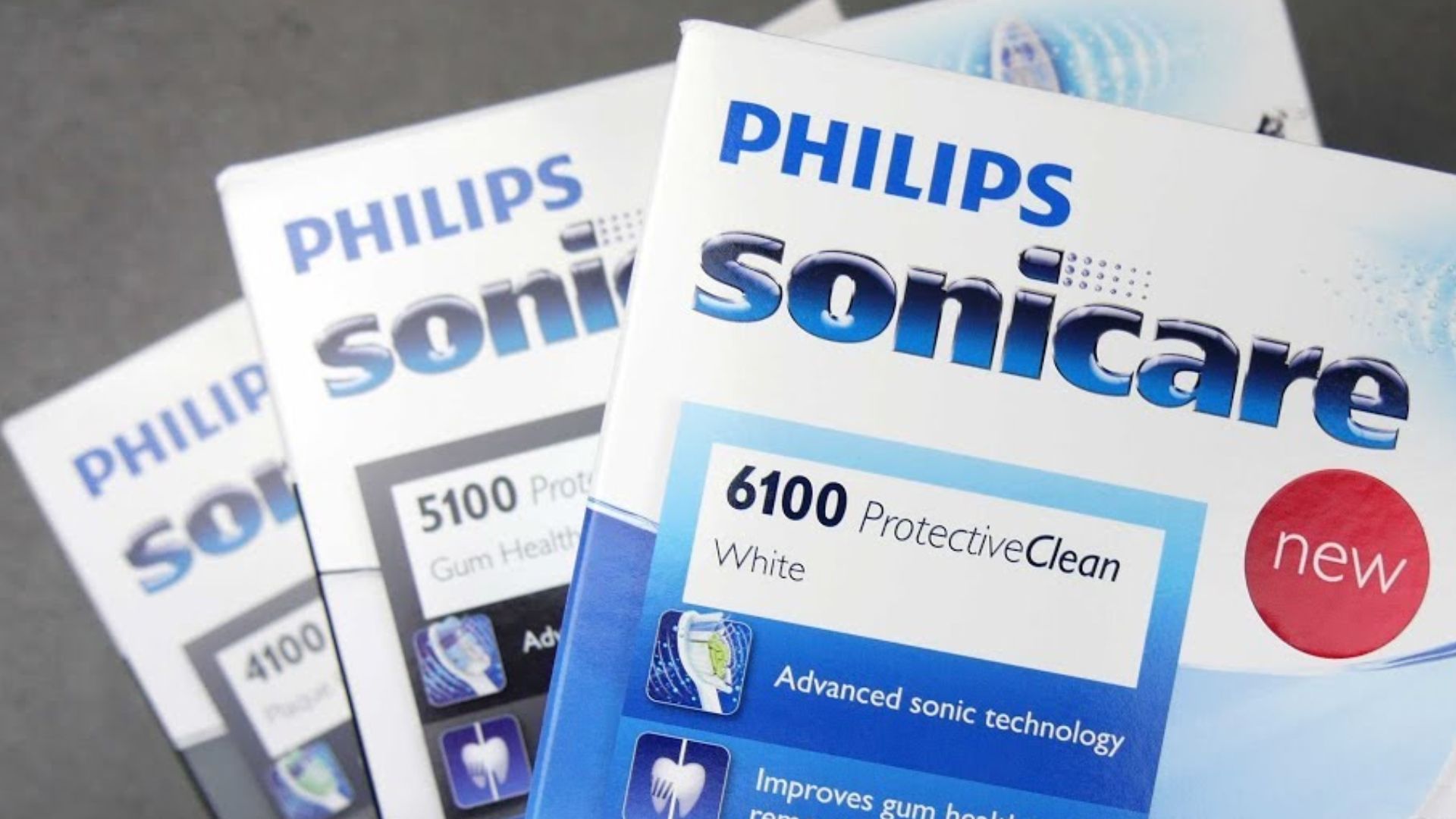
Detailed comparison: what’s the difference between the Sonicare ProtectiveClean brushes?
As differences go between these electric toothbrushes, the reality is that there are not that many, there are many more similarities.
However, the subtle differences that do exist can potentially make a big difference to you and your experience and 1 brush might better suit you and another.
Whilst there is a summary of the differences above, let me explain these in more detail.
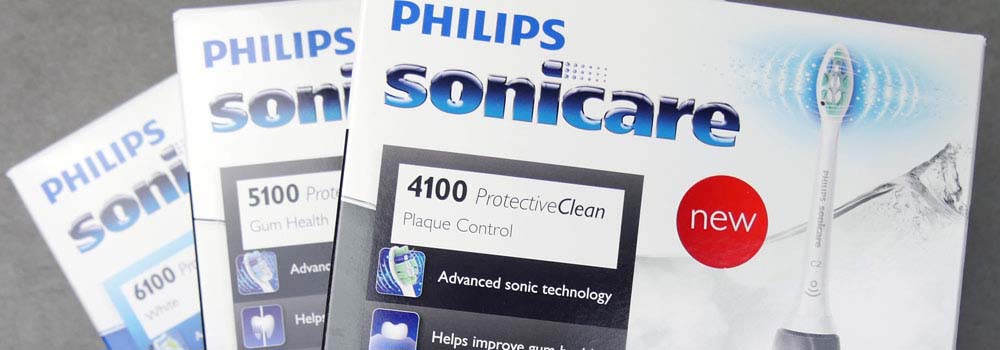
The first thing to be aware of, if you are not already, is that the 6100 is the most premium and feature rich, with the 5100 below that and the 4100 being the base model within the ProtectiveClean family.
However, despite being the base model the 4100 offers a lot of fantastic features and more than ticks the boxes for an everyday electric toothbrush.
Starting with the cleaning modes, the brushes offer as follows:
- 4100
- Clean
- 5100
- Clean
- White
- Gum Care
- 6100
- Clean
- White
- Gum Care
As you can see, the 4100 offers just 1 cleaning mode compared to the 3 cleaning modes of the 5100 and 6100.
The Clean mode operates in the exact same way on the 3 models, as White and Gum Care do on the 51 and 6100.
Clean lasts for 2 minutes, White 2 minutes and 30 seconds and Gum Care 3 minutes.
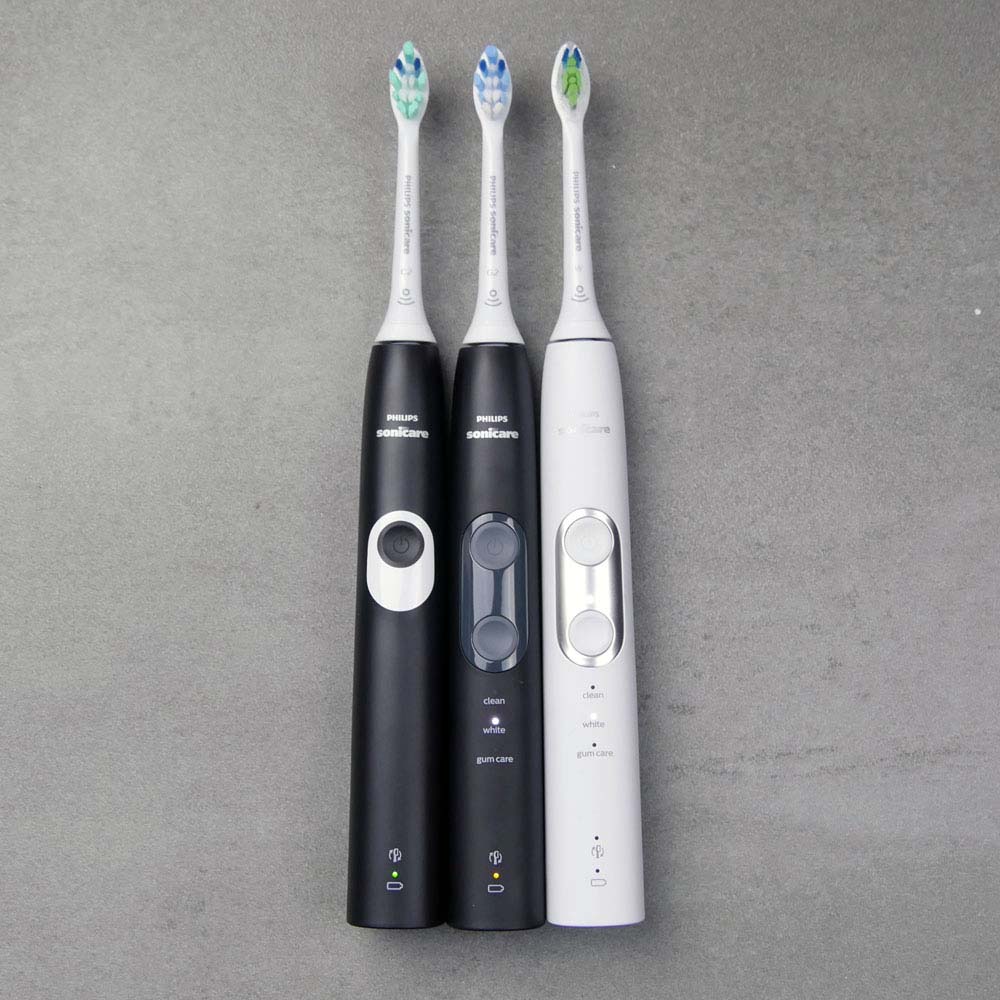
The extra 30 seconds for the White mode are to spend focusing on the front teeth, whilst the extra minute on Gum Care mode is for cleaning and stimulating the gums.
We explain all of Sonicare's cleaning modes in detail in this post.
The additional cleaning modes do influence the design of the brush handle slightly.
On the 4100, there is just a single power button, but no icon or LED to symbolize the 1 and only cleaning mode.
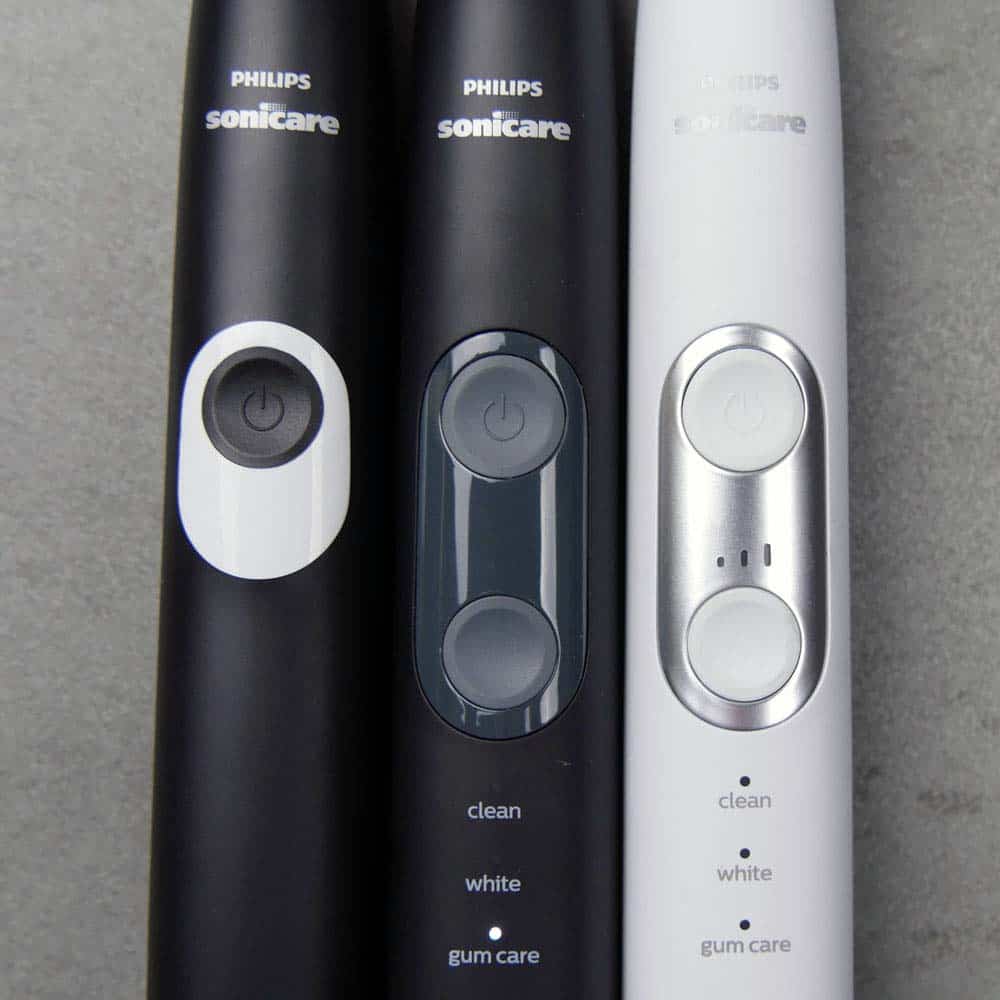
With the 5100 and 6100 the brush handles have an extra button below the power button to change the cleaning modes, but also the names of the modes, complete with an LED below that.
Running vertically down the handle, they read, Clean, White, Gum Care with an LED between each.
That LED shines White when the cleaning mode button has been pressed to select that mode.
Around the power and cleaning mode button on the 5100 and 6100 is a plastic panel to accent the handle and add a design cue.
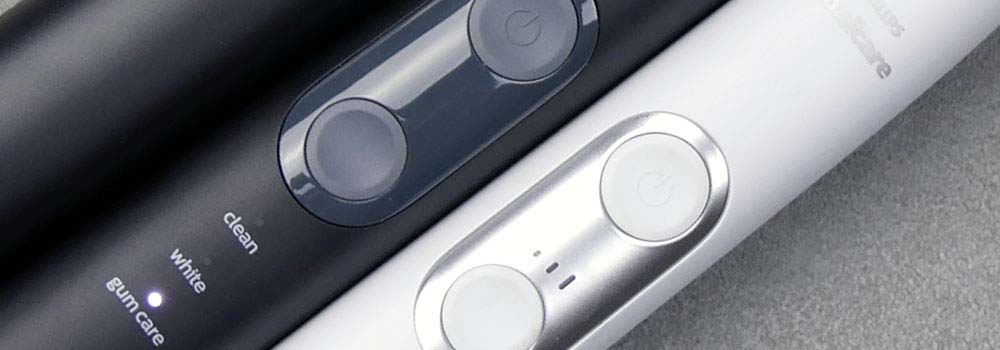
Setting the 6100 apart from both models is the fact that it has 3 different cleaning intensities.
Controlled by the cleaning mode button, you have 3 intensities, low, medium and high that changes the power and brushing sensation delivered from the brush through each cleaning mode.
Whilst this is by no means essential, it adds an extra dimension to the cleaning experience and allows you to tweak the power to be more appropriate and comfortable for you.
This works for a number of reasons. You might have inflammation or sensitivity and want a more gentle clean or you may share the handle with older children who could benefit from less power delivery to be more gentle on their teeth and gums.
In the box with each brush handle comes a brush head, but each brush comes supplied with a different style of head.
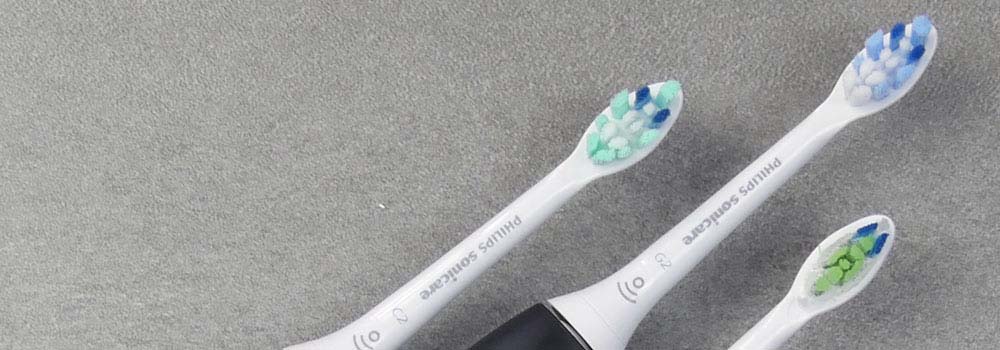
They come with the following:
- 4100
- 1 x C2 Optimal Plaque Control
- 5100
- 1 x G2 Optimal Gum Care
- 6100
- 1 x W DiamondClean
The cut and configuration of the bristles are different on each of these heads to achieve different results.
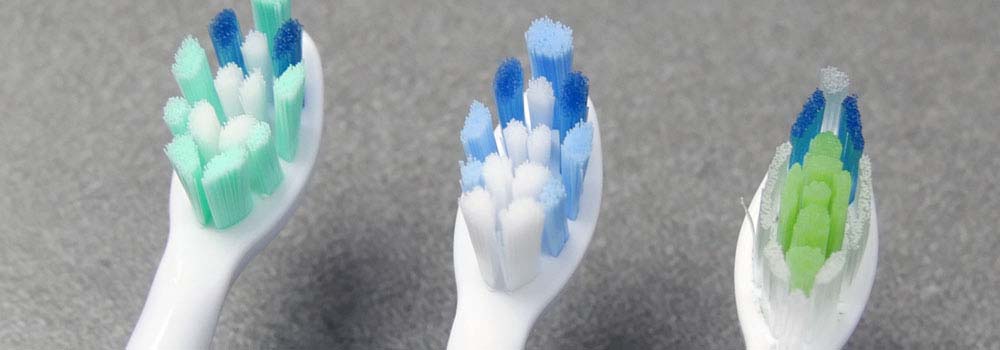
Each does work best on particular cleaning modes too.
- C2 Optimal Plaque Control
- Works best with ‘Clean’ mode
- Removes up to 7x more plaque
- G2 Optimal Gum Care
- Works best on ‘Gum Care’ mode
- Improves gum health up to 100%
- W DiamondClean
- Works best on ‘White’ mode
- Up to 100% less stains in 7 days
Much more detail is provided in our ultimate Philips Sonicare brush head guide but, you can perhaps see why each brush head comes supplied with each brush and how using the Gum Care brush head is likely to deliver better results when used on the Gum Care mode than others.
Despite being better suited to particular modes all Sonicare brush head can be used on any cleaning mode.
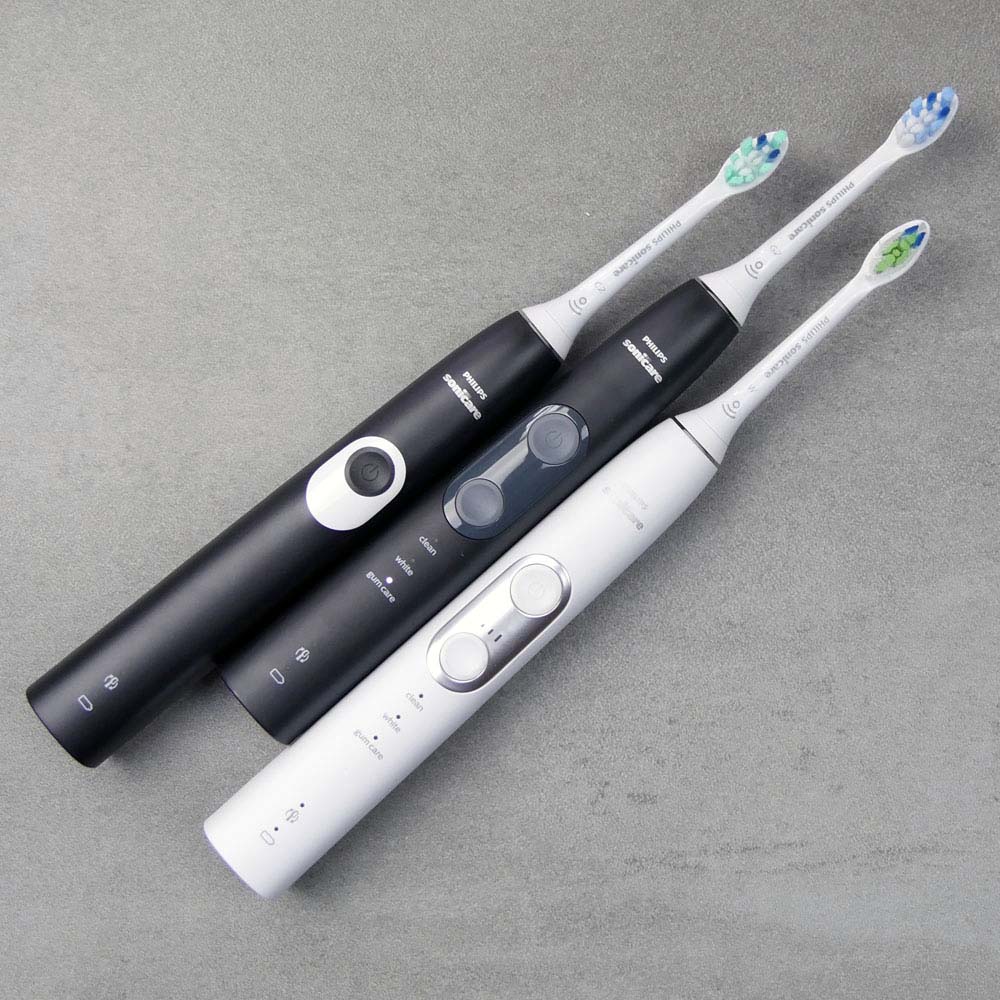
All 3 models have a technology called BrushSync.
What this does is tell you, via an LED on the brush handle when it is time to change or replace your brush head.
Inside the brush head supplied is a small RFID microchip.
When the brush head is fitted to the brush handle, the chip is detected and the warning light will flash 3 times. This acts as confirmation that the handle has detected the head and that the electronics inside the handle will now keep track of it.
As you use the brush head, the handle continues to track how often it has been used.
The handle knows that the brush head should be replaced every 3 months, so once the handle detects that the brush head has been used for this amount of time, the ‘BrushSync’ LED on the brush handle will light up an Amber/Orange color. It is at this point you should fit a new head.
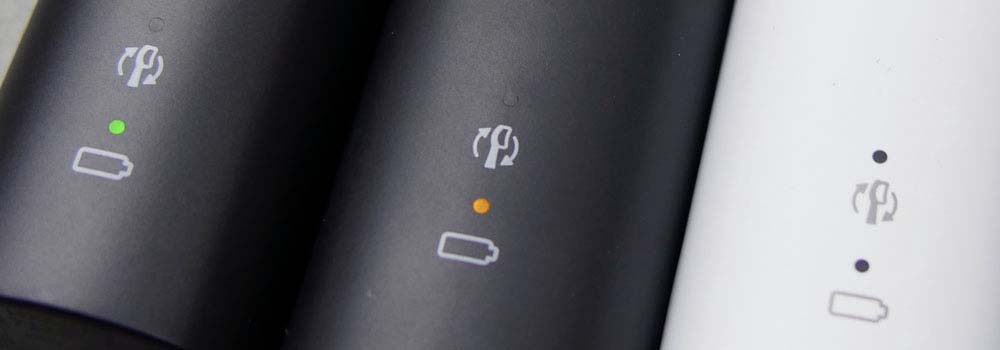
But, it goes further than that.
If it detects you have brushed 3 times a day every day or brushed with more pressure, it will activate the BrushSync alert system sooner, as the bristles will have worn out sooner than the typical 3 month time period.
It will also delay alerting you to replace the brush head. If you used that head just once a day over 3 months, it would not tell you to replace it until it had been used for the equivalent to 4 minutes a day for 3 months.
This is just 1 part of the BrushSync feature, the 6100 is the only brush handle in the ProtectiveClean range to offer the BrushSync mode pairing.
Mode pairing matches the brush head and the cleaning mode.
Each head has a mode it works best with, so the handle of the 6100 automatically sets this mode as you fit the brush head.
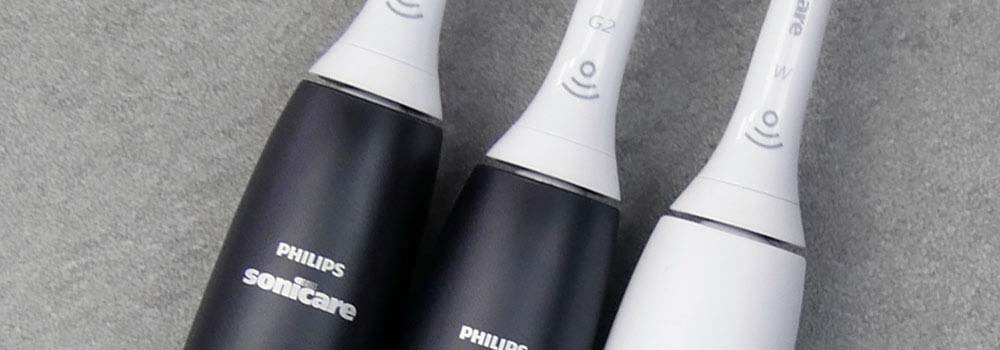
So, if you were using a C2 Optimum Plaque Control brush head on the clean mode and you fit the W DiamondClean, the brush will automatically switch the cleaning mode to White, so it is already set up for the best results when you switch the brush on.
I don’t believe it is a feature we are all crying out for, but as things go, it is a nice addition and makes further use of the microchip in the brush head.
There are just a couple of difference left to explain.
Both the 5100 and 6100 come supplied with a travel case, the 4100 does not.
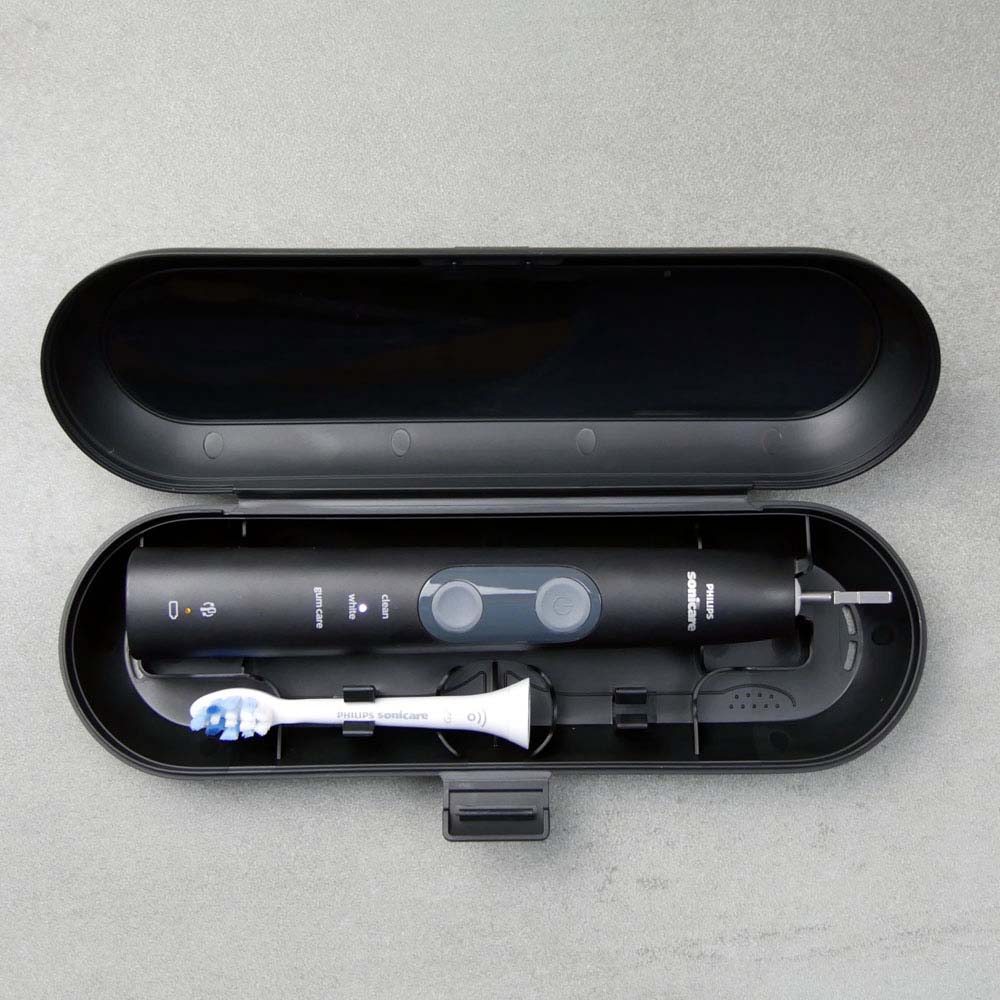
Plastic in construction, it is hinged on the left side with a clip on the right to securely fasten it closed.
Inside it holds the brush handle and up to 2 brush heads.
It protects the handle and the heads from accidental damage and activation.
The final major difference between these 3 models is the color of the brush handles.
All 3 models can be purchased in different color choices. Technically their features and performance are the same, just the color of the handle that differs.
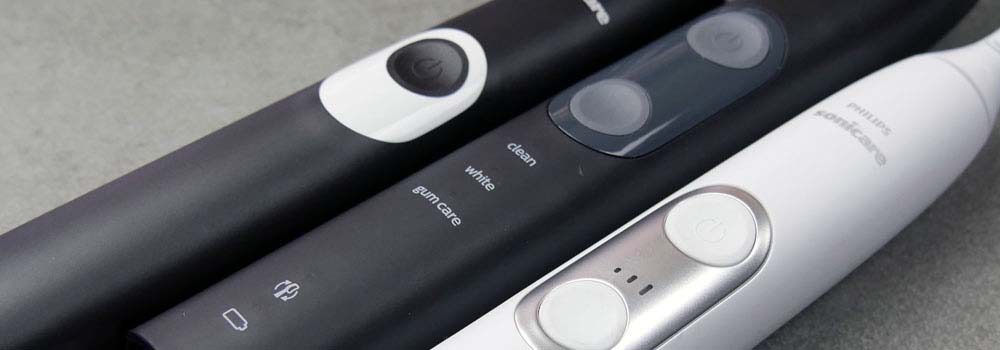
Those choices and the official Sonicare part codes are listed below:
- 4100
- White & Mint - HX6817/01
- Black & White - HX6810/50
- 5100
- White & Mint - HX6857/11
- Black Gray - HX6850/60
- 6100
- Silver White - HX6877/21
- Pastel Pink- HX6876/21
- Navy Blue - HX6871/49
With the main differences between each now explained, I think it is worth highlighting some of the ways in which they are similar that I have not already mentioned.
The design of the brush handles are very similar. Yes, the 5100 and 6100 have a bit more going on because of the additional cleaning modes and brushing intensities, but they are of a rounded design, with a smooth to the touch paint finish.
Not too slippery in hand, none have extra rubber grips like some other brushes do.
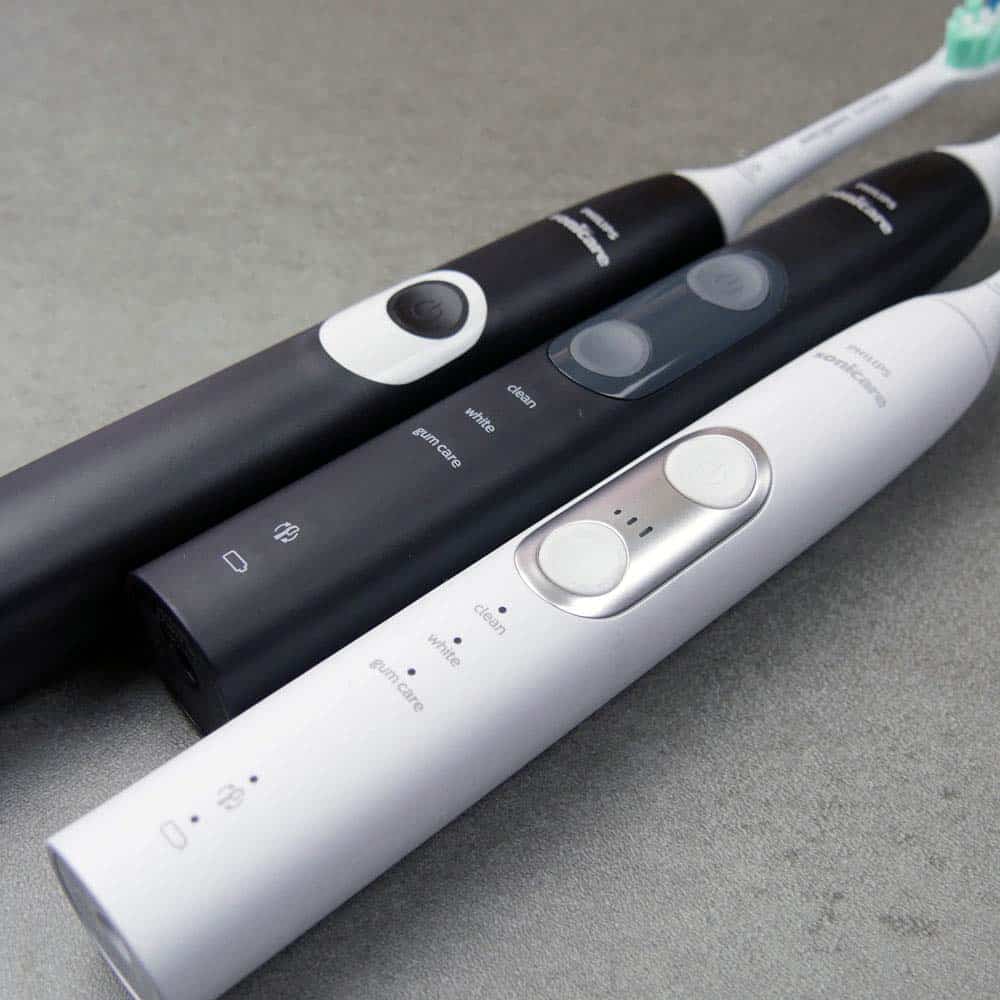
All have a motor built-in that can deliver up to 62,000 movements (31,000 brush strokes) per minute that is powered from a Lithium-Ion battery built into the handle.
The non-removable battery gives at least 2 weeks usage or so Sonicare claim. The reality of the situation is things are much more positive.
Some variance in the battery life will come as a result of the different cleaning modes that run for longer and brushing intensities, but I achieved 20 days on the 3 minute long Gum Care mode and 37 with the 2 minute long Clean mode. That is quite a bit longer than 2 weeks.
All models come with a charging stand, that has a prong on the top that fits into the base of the brush handle. Sitting upright on the stand, the power adapter connects to a US socket and the brush can take up to 24 hours to charge fully.
The stand itself supports voltages of 100-240v, meaning if you travel with the charging stand you need only a plug adapter rather than a voltage adapter.
When in need of a charge, all give feedback through the LED mounted on the front of the brush handle.
A solid Green LED means a full battery.
A flashing Green LED means a medium battery.
A flashing Amber LED and three beeps means a low battery.
A flashing Amber LED and five beeps means no brushing sessions left, you need to charge the toothbrush.
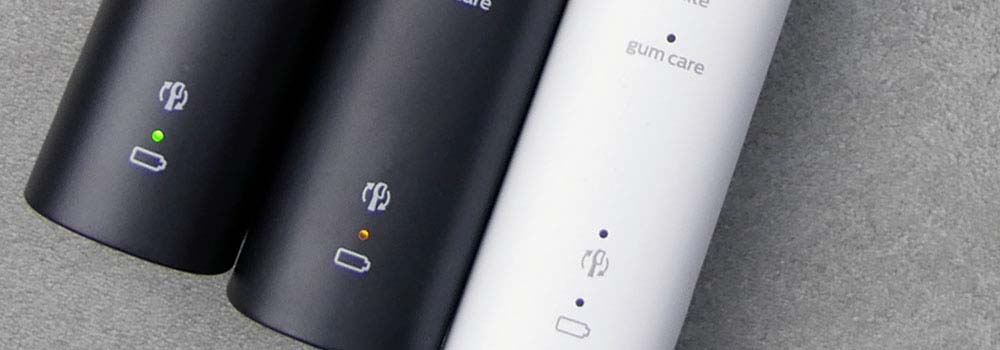
Additional features built into the handle include a pressure sensor, that vibrates through the handle and changes the brushing sensation to alert you to the fact you are brushing too hard.
A timer and quadpacer are present to encourage you to brush for the right amount of time and evenly.
Providing you allow the brush to come to the end of the cleaning cycle, the brushes will turn themselves off to signal the end of the clean and conserve battery life.
An EasyStart feature is built-in and switched on from the moment you unbox the brush.
This increases the power of the brush mode over the first 14 brushing sessions to ease new users into the increased power the brush delivers.
Solid and well constructed the handles are, they are designed to resist water, so a rinse under the tap to wash off toothpaste and saliva is absolutely fine.
Whilst high standards of manufacturing are achieved by Sonicare, the nature of the product does mean that there is the potential for things to go wrong.
A 2 year warranty is provided as standard, but this can be extended by 6 months if you register the rush online.
Does one clean better than the other?
Potentially yes, but for the most part, there is no difference between how these 3 clean.
Ok, so the answer to this question is a bit more difficult to answer and I will explain why.
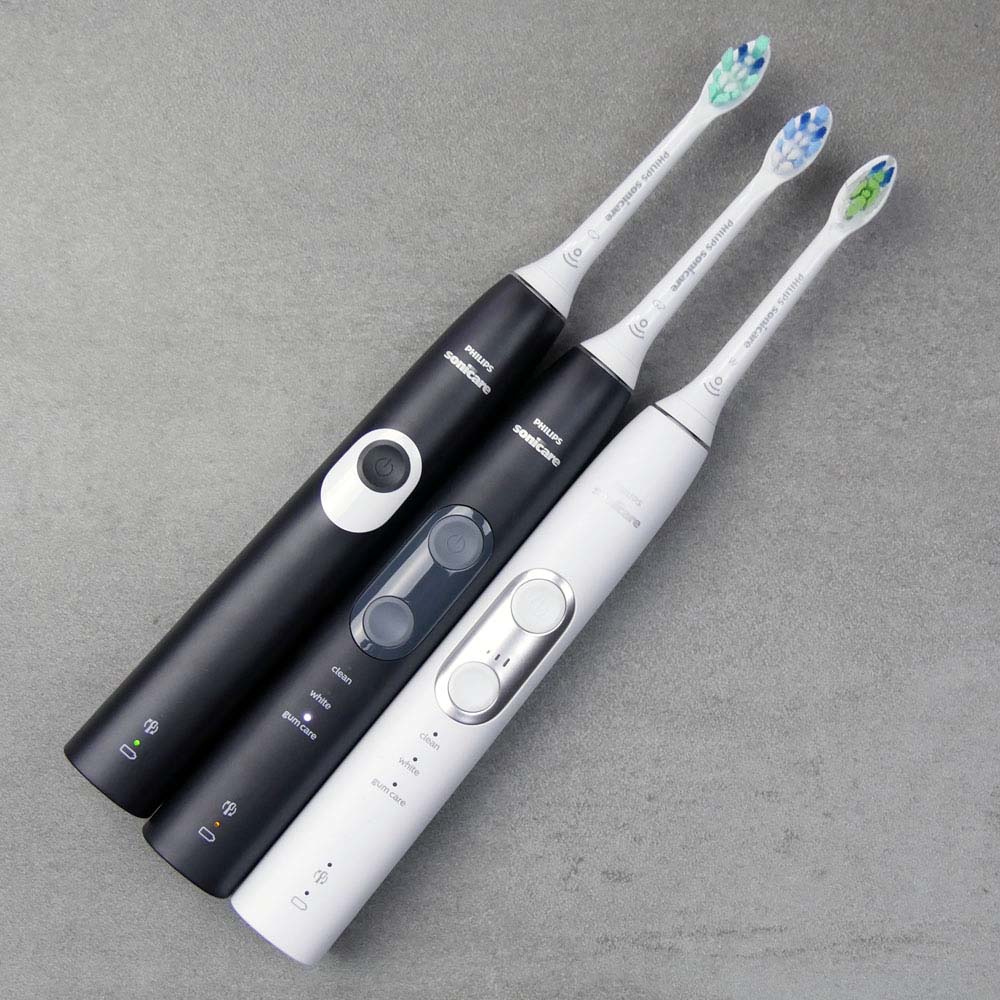
All 3 models have an internal motor that can offer up to 31,000 brush strokes per minute.
The 4100 offers just 1 cleaning mode (Clean), compared to the 3 modes (Clean, White and Gum Care) available on the 5100 and 6100.
Each cleaning mode has a different running time and uses the power of the motor in different ways to achieve the final result.
Clean lasts for 2 minutes, White for 2 minutes and 30 seconds, whilst Gum Care lasts for 3 minutes.
The 6100 is the only brush to have the ability to change the power of each cleaning mode between 3 intensity settings, Low, Medium and High. This, therefore, changes the way in which the brush cleans and its effectiveness, but does allow you to change the power to something you are comfortable with.
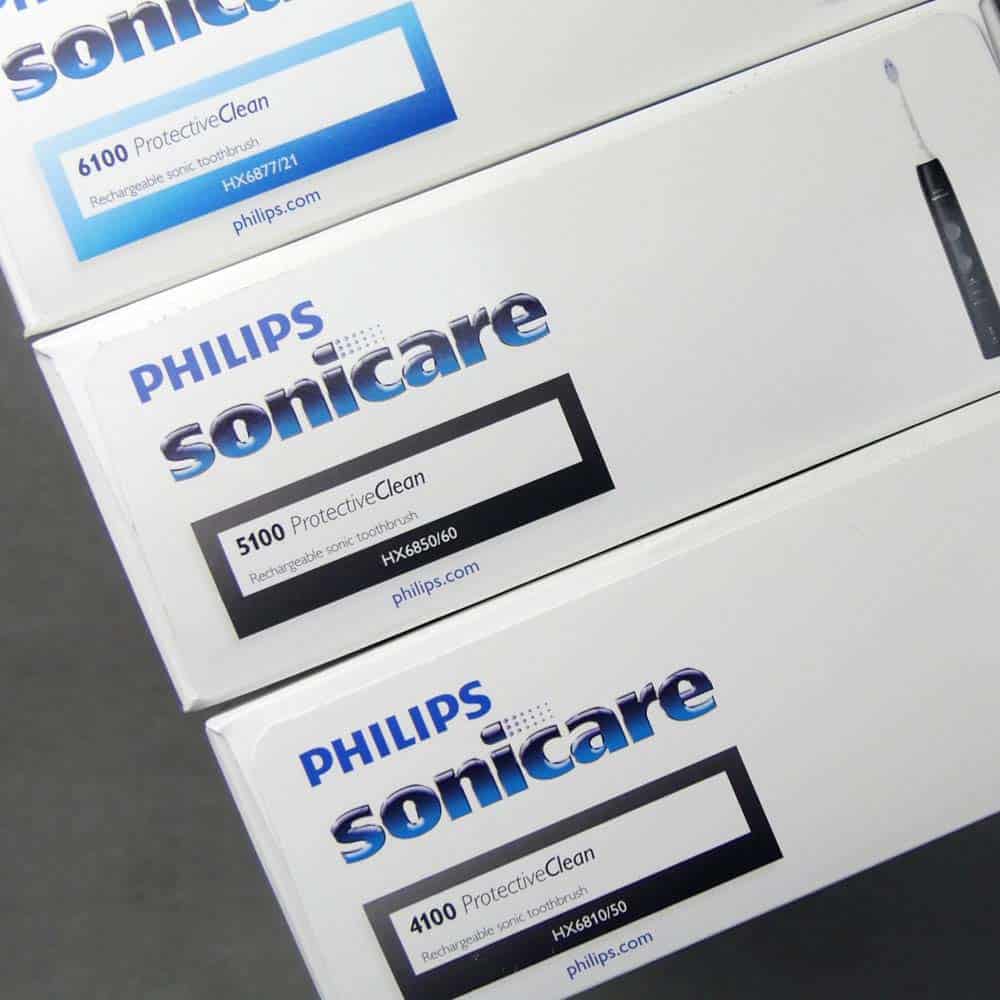
Therefore, in theory, if you used the ‘Clean’ mode on all 3 brushes, making no change to the default intensity on the 6100, then the cleaning experience they deliver would be identical.
It can be argued that the 5100 and 6100 can offer a better Gum Care and Whitening focused cleans over and above the 4100 because of the extra modes they have.
So if you want whiter teeth, you might not get quite such good results with the 4100 as you would with the 5100 and 6100, but this is harder to prove in the real world.
All 3 brushes accept different brush heads. Different styles of brush heads can achieve different results. We cover brush heads in more detail in our post on sonicare brush heads.
A W DiamondClean head used on the cleaning mode might not be as effective as when used on the ‘White’ mode.
To achieve the best possible results, using the most appropriate brush head for the cleaning mode and sticking to the default cleaning settings and power is the best course of action.
No clinical studies or comparisons have been made and I would believe the possible differences or improvements between each to be clinically insignificant.
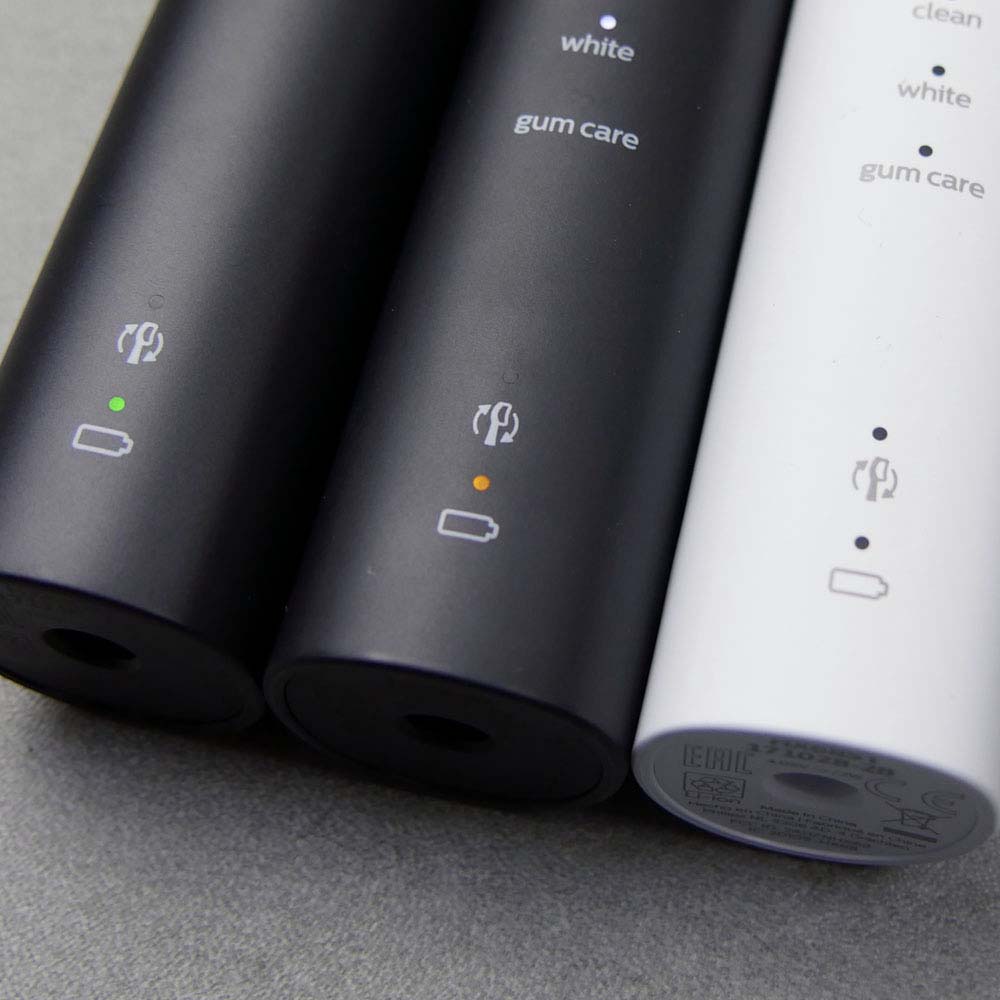
The reality is, there are many other variables that come into play and affect how well the brushes clean more than the cleaning modes or brushing intensity.
Those cleaning modes and intensities are in part about your cleaning experience, the sensation and comfort of brushing more than how well it cleans.
Whilst technically there might be some difference between the models only possible to observe under a clinical trial, bigger factors that influence how well a brush cleans is the way in which the brush is used and how frequently.
If you brush twice a day for 2 minutes everyday and use the right technique with any of the electric toothbrush models discussed here, the results are likely to be significantly better than someone who only brushes once a day or with the wrong technique.
You may get better or worse results than a friend, as your teeth and previous oral health is different.
So, with all this said, whilst there might be the potential for a better clean from 1 brush over another if you are trying to achieve a particular result, for the average user, the clean offered by the standard ‘clean’ mode is identical.
Is one better priced than the other?
Yes, the ProtectiveClean 4100 is the cheapest.
The 5100 is more expensive and the 6100 the most expensive.
The suggested sale prices are $69.99, $89.99 and $129.99.
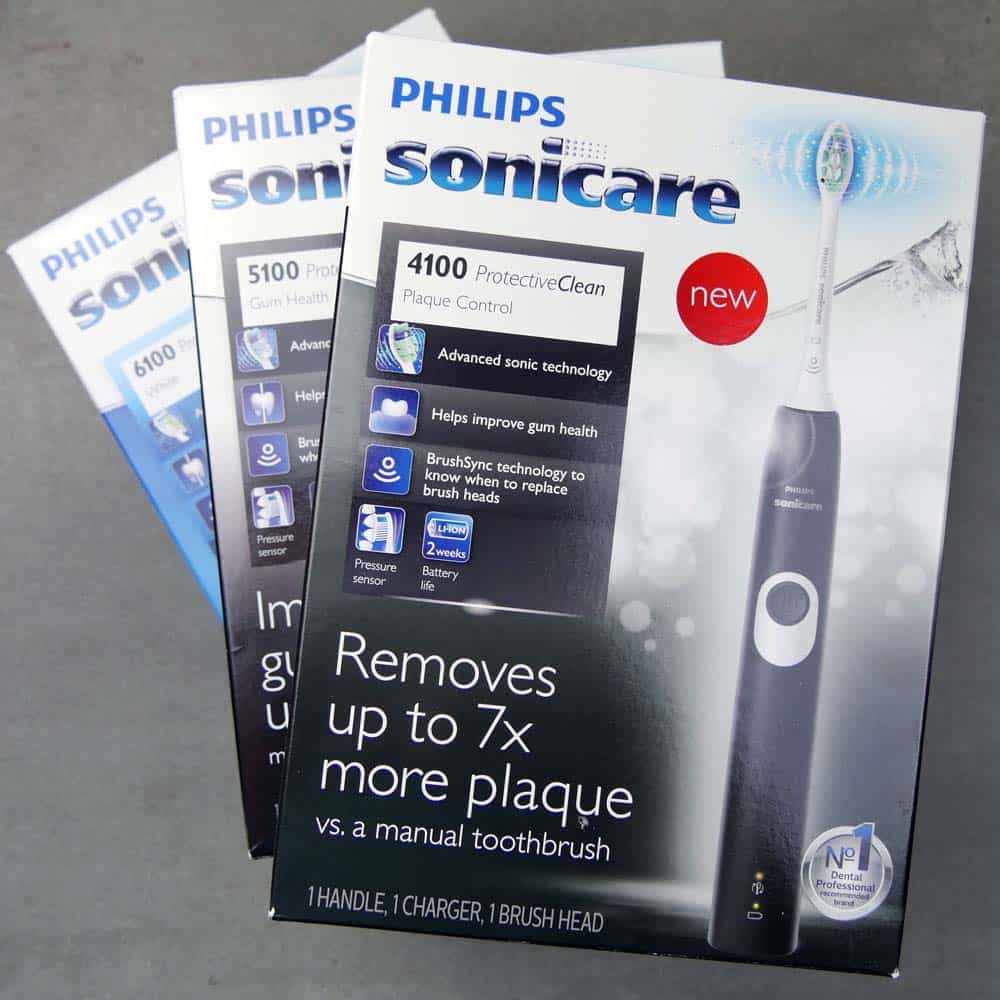
However, actual selling prices are a little cheaper at around $50, $80 and $110.
Given that each brush offers more features as you climb up through the range it is not unsurprising that the cost increases too.
Influencing my verdict slightly is the price. Both the 4100 and 5100 represent good value, the 6100 is still not overpriced, but slightly harder to justify given what it offers and how many want such features.
Please note that all prices quoted are approximates and will vary based on location, supplier and time of purchase. These figures were correct at the time of writing and should not be relied upon as hard fact, but used as a guide during your decision process.




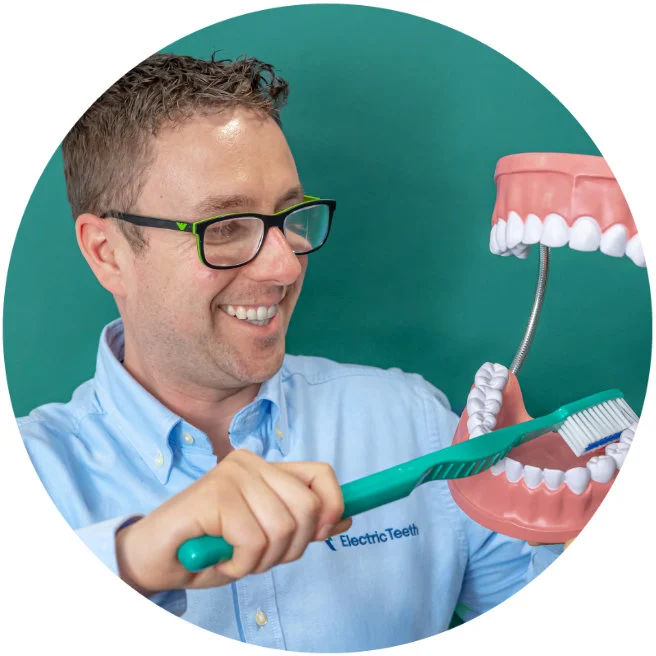
So cant you just turn on the 4100 for another 30 seconds to a minute and get the same results you would get with the 5100 and 6100
You can turn it on again yes. It will run another 2 minute brushing cycle. BUt, you can stop it when you like by pressing and holding the power button for about 2 seconds.
I want a sonic care electric toothbrush that I can plug into the
wall outlet. I do not want the ones with USB. Where can I find them.
There are quite a few Soincare models that have the 2 pin wall charger rather than USB.
The ProtectiveClean 5100 & 6100 are 2 examples of this.
The models that come with USB chargers are the Sonicare 1100, 2100, 3100, 4100, 4300, 4900 Series and Sonicare 9900 Prestige. So avoid these.
That said the 1100, 2100, 3100, 4100, 4300, 4900 Series do work on the older style chargers without a USB port. You just need to purchase this stand seperately, if you don't already have one.
How do I order the travel case separately to replace a broken one? Not seeing the option on the website.
Hi Ben.
Try visiting https://philips.encompass.com/parts-accessories/Philips-Oral-Healthcare to see if they have the case you want.
Amazing website with useful information
Does the Sonicare 4100 plug directly into an electric outlet or does it require an adapter?
The Sonicare ProtectiveClean 4100's charging stand has a 2 pin plug connected to it. There is now a newer 4100 Series (the replacement to the ProtectiveClean 4100) that does require an adapter for the charging stand. The charging stand with the 4100 Series has a USB connector rather than 2 pin. No USB to 2 pin adapter is provided in the box.
Thank you very much for the helpful summary, I really appreciate it!
Speed/Strokes, Vibration and Intensity/Modes. I tried to pin down Philips customer service on all the mystery surrounding different speeds and modes because I have sensitive teeth. I was told if you buy a brush with a "Sensitive" setting the speed will be 15,000 strokes. He suggested a possible workaround when I mentioned the ProtectiveClean model. He said w/ProtectiveClean, you can drop the mode to the "Low" intensity setting and this will drop "vibration". However, it will NOT drop the strokes/speed. So looks like I need to splurge on a model with the Sensitive setting.
Btw Jon, fantastic website you have provided for us !!
Thanks Andrew.
There is quite some mystery around the speed/strokes, vibrations, intensity and modes as you say. Even with some information, it doesn't always help.
Are you using a Sonicare or electric toothbrush at the moment?
I guess it depends how sensitive you are to the intensities etc, but maybe a soft bristled head will help some.
You can pick up some better value models with this option, especially if you opt for older models.
Currently using an old Sonicare Flexcare (battery is dying) with a sensitive setting and sensitive brush head. Flexcare has disappeared from the Sonicare website. Now they're looking for $400 to get a brush with a sensitive setting. And to go from 2 intensity settings to 3 intensity settings the price jumps from $40 (4100) to $120 (6100).
Andrew, I don't know if this would work for you, but there are some new models, Sonicare 1100, 200 & 3100 Series that offer 31,000 movements, so 15,500 brush strokes.
They only have 1 cleaning mode, but the intensity is less than the standard cleaning mode on more premium Sonicare models that typically offer 62,000 movements/31,000 brush strokes.
They are good value too.
The 2100 might be a good choice as it has 2 intensity settings compared to the 1 only on the 1100 and 3100.
As it happens, I have just published my review of this model, here.
Updated hands on images and review video coming soon.
Hi Jon,
Thanks for your great info.
I would like to know if the 5100 and 6100 differ in weight or size of the handle? Also are the travel cases the same size?
I need gum care so I am interested in the different intensities the 6100 offers, but I also travel a great deal and need something that is convenient for travel.
Thanks,
Jo Ann
Hi Jo Ann,
The handle size is basically identical. They share the same body.
The 5100 measures in at:
Height (without head) – 19cm/7.4 inches
Height (with head) – 25cm/9.8 inches
Width – 2.8cm/1.1 inches
Thickness – 3cm/1.1 inches
Weight (without head) – 125g/0.27lb
Weight (with head) – 130g/0.29lb
The 6100 measures in at:
Height (without head) – 19cm/7.4 inches
Height (with head) – 25cm/9.8 inches
Width – 2.8cm/1.1 inches
Thickness – 3cm/1.1 inches
Weight (without head) – 126g/0.27lb
Weight (with head) – 132g/0.29lb
Please note these measurements are approximate based on my measuring with rulers & scales.
I am also not aware of any size difference in the cases.
Thank you so much for your careful research and prompt reply!
Best wishes to you Jon.
Still no word on the DECIBEL rating!
Hi Joy. I replied to your previous comment here, saying they are about 60dB.
Could you please tell me the decibel rate for the models? I am looking at the HX6829/72. As I remember, these units are pretty loud.
Thanks!
Hi Joy. These models are in the region of 60dB when in use.
Thanks! I don’t know how I missed that. Why so loud?
This is actually a pretty typical decibel reading for a sonic toothbrush. It is the way they work. Oral-B models are quite a bit louder still. Our article about the quietest electric toothbrushes might be worth a read. It does offer a couple of quieter options.
A very helpful analysis of the three brushes! Well done and logical. It has helped me to select the replaceent for the sonicare I have. Thank you.
Such great information! Thanks for making this so much clearer!
I heard also that there is "AdaptiveClean"Toothbrushes
There is/was a brush head called 'Adaptive Clean' which is now being phased out by Sonicare in preference for their new brush head styles. This head is explained in more detail on our Sonicare brush heads page.
hi
i found these 2 in the same price
Philips Sonicare DiamondClean Electric Toothbrush, 2019 Edition
philips Sonicare ProtectiveClean 6100 Electric Toothbrush
on amazon uk
which is you think the better ?
the thing i like about 6100 without using it there is 3 Intensities so i can use low Intensity
i dont know if Dimond has it under different name like sensitive mode may be ?
thanks
I would go for the ProtectiveClean 6100.
You do miss out on the case that you can charge the brush inside, but unless you need this, I think the features and overall package are better on the 6100.
Excellent information - not only this article but in general. Keep up the good work!
Thank you John. 👍
hello. this has been a super helpful read. i do have one question that i don’t believe has been covered.
i have an issue with gum recession and teeth sensitivity. i am looking to switch to a sonicare brush to help with this. the 6100 offers 3 intensities, which of those 3 intensities is the base line for the 5100. if the 5100s one intensity is comparable to the lowest intensity of the 6100 then i will purchase the 5100. if i can get a less intense vibration with the 6100, in low mode, i will spring for the more expensive model with all the bells and whistles i don’t need.
i’m looking to use the mellowest intensity and am not clear on which brush would be best.
thank you!
Hi Nicole.
Pleased to read that you found the article helpful.
The question you ask, is a very good one, and it is not one I actually answer in this written comparison.
I have to be upfront and say I cannot give a 100% confirmation of an accurate answer, as Sonicare does not provide any clear information on the number of movements/brush strokes for different cleaning mode and brushing intensities. I have event asked their support team and they were unable to confirm what power each mode used.
They don't, for example, say a low intensity is 10,000 brush strokes, 20,000 for medium and 30,000 for high.
From what I can tell, from use and observation, that the 5100 works at the highest intensity available on the 6100. The gum care cleaning mode could well be different, but I cannot say precisely.
So, based on what you are saying, I would advise going for the 6100, as this way you have the ultimate control.
You might be interested to know that Sonicare offer a 90 day money back guarantee. This could be useful for you as it is your first Sonicare and you may not find it works out. I hope it does, but just in case, the option exists.
Jon - thank you so much for taking time to write such a thorough, exhaustive review of these brushes. Your candor and honesty shine through and it is so helpful to hear from a real person what all the pros and cons are of all the brushes. I will be happy to read your reviews if I ever need more help and will be sure to pass your name onto others who are interested in learning about brushes.
Hi Josh. Thanks for the wonderfully kind words. Very pleased to read that I have been able to help. 😁
My daughter is 7. Would a 4100 be alright or should I be looking at one of the kids lines?
Hi James,
It is a bit borderline to be honest. From about 8 years old children can begin normally moving up to the adult sized brushes.
It is not to say your daughter cant use the larger adult brush heads, but the size of them and her mouth might restrict the cleaning abilities a little.
Not ideal, but possible would be to fit the child's brush head to the handle of the 4100 for a year or so. You will loose the brush head reminder system that is built into the 4100 if you do this.
My 13 year old son has staining on his front teeth. They clean up well at the dentist, but they recommend we get him a Sonicare. (Currently uses an Oral B 3756) For this staining issue with him being younger, I'm wondering what model and what bristles you think would be most effective while still being gentle. Thank you.
Hi Jennifer.
The Sonicare 4100 really should be more than adequate for your son. The 5100 and 6100 have extra benefits, but they are not 'required'.
The brush head provided will be sufficient, but many people prefer the slightly softer bristles of the G2 Optimal Gum Care Brush Head.
Went with your recommendation. Very happy with my purchase. Thank you for the quick reply.
Hi there.
I have a question, does the 4100 whitening your teeth also during some time of usage ? Because 5100 and 6100 offering whitening separately. Because for my usage I prefere both cleaning and whitening. But I dont have now to much money to give for 6100 for example...
Hi Alex,
You do not need a specific 'whitening' mode to whiten the teeth.
Using the 4100, twice a day for 2 minutes each time and brushing with the right technique and with a good toothpaste is going to for the most part bring whitening results as good as using the whitening mode.
I have seen little/no evidence that these specialist modes will have any beneficial whitening effect. This has been confirmed by our in-house dentists.
This 'whitening' is actually only helping remove the external staining on the teeth.
So yes, go for the 4100, you don't need the 6100.
Thank you very much for your answer Jon!
Then I will go for 4100, I hope I will be satisfied.
I am pretty confident you will be happy.
Just in case however, you might like to know that Sonicare do offer a money back guarantee.
I didnt know that... Thanks for info.
Have a good day !
I have one more question, there is Sonicare Protective Clean 4300 also. What is the diference between 4100 and 4300?
Alex,
The 4300 is a model for Europe as far as I am aware, this is not normally sold in the USA.
I didnt know that... Thanks for info.
Have a good day !
Hi Jon,
Thanks for all this information. Its very clear and helpful. I was initially looking at the DiamondClear line. I thought the app would be fun but decided I didn't need a WIFI enabled object in my mouth 2-3x a day. So i found myself here comparing the 5100 vs the 6100.
I have some questions:
1. Are the movements (62000 vs 31000) the same on the DiamondClear and the *100 series? I saw the discussion above but wasn't sure to what conclusion you came.
2. Do you know if the white mode and/or white head really work? I know the white mode gives you time to brush the front of your teeth longer but I feel like I could brush my front teeth all day and they wouldn't change much if not at all. I read your article on brush heads but was wondering if you had an opinion on the DiamondClean head efficacy.
Thanks so much!
Hi,
Thanks for the comment.
In answer to your questions.
1. Yes the movements on the DiamondClean and *100 series are the same. Sonicare interchangeably use 31,000 brush strokes and 62,000 movements when quoting the power/speed of the brush. The 62,000 makes things seem better, when it is just another way of describing the 31,000 brush strokes. 1 brush stroke is equal to 2 movements. (31,000 x 2 = 62,000). There is a slightly more detailed answer to explain this fuller, but I hope this summary is enough.
2. I cannot categorically say the White mode does not work, but my personal feeling is no not really for most people. Technically in could, but there are certain circumstances where this would apply. I am happy to explain further but again its an extended answer that will summarise it may work so some and not others!
The DiamondClean head is perfectly fine. I have no evidence to say 1 is really better than another. As a general rule we suggest the ProResults as it is designed a little more with 'all round' cleaning in mind whereas the DiamondClean is geared slightly more to trying to whiten teeth. Efficacy wise there are claims Sonicare make but this is never compared to one of their other brush heads so really understanding how good a brush head is, is difficult. Ultimately, there will be more improvement/efficacy to be gained from mastering the brushing technique and regular brushing for the correct time than any brush head can bring.
I hope that helps.
If you want the more wordy explanation on both I am happy to provide this.
Thanks Jon for your prompt response. I think maybe I will just use the Pro head at night and the DiamindCkean in the morning after coffee and see if that helps!
Hi - I'm looking for a new sonicare, my old one of 6+ years is giving up.
I find the Sonicare product lines terribly confusing. I'm looking at the ProtectiveClean line and DiamondClean. You mention in some other articles that the DiamondClean goes up to 62000 strokes per minute, and the ProtectiveClean is up to 32000. Is this correct? I saw a press release on ProtectiveClean mention the 32000 number, but the Philips website says 62000 for everything.
For ProtectiveClean line, the 6100 only has the intensity options. Do you know what the default intensity is for the models that don't have this? I generally don't care about all the different modes, but if the intensity option allows me to get more power then I might lean toward the 6100.
Lastly, any opinions between The ProtectiveClean and DiamondClean line?
Hi Tommy,
Thanks for the comment.
Sonicare do not make things easy. Their website is confusing when the mention the number of movements as like you say the site says 62,000 but I can say from actually handling the product, the box says 31,000.
Given what you say, it is unlikely you need the DiamondClean range. They offer different modes, which in essence are like different intensities.
I don't honestly know what the speed of the motor is at the lowest intensity compared to the higher brushing intensity. If I had to make an educated guess, if full power is 31,000 movements per minute, the medium intensity would be around 22,000 and low intensity is probably roughly 15,000.
I think you would be very pleased with the 6100 for what it offers. Your getting 3 modes, plus 3 intensity levels. There is a travel case in the box too.
I hope that helps.
Thanks for your reply. Do you happen to know what the maximum brush strokes for the DiamondClean line is?
Tommy, finding out what is actually the correct answer is quite tricky. The Sonicare website and some of their documents say up to 62,000, but I have seen plenty of instances where the same product is mentioned with just 31,000 movements.
I have checked the box I have and there is no mention of the movements for this model.
Amazon (who are one of the biggest sellers) state here on their product pagethat it is 31,000.
I have no other way of checking. It could be worth contacting Sonicare customer services, but I fear information will be just as confused!
I think I figured it out. It seems like in some places philips advertises a half-stroke number (62000) and in other cases a full stroke (31000). Half stroke being going to one side only. Also on their website they say the Clean mode delivers up to 31000 strokes, which makes me think there wouldn’t be any difference between a protective clean 4100 and a diamond clean. The White mode appears to just add 30 seconds on top of Clean, so I’m thinking the other modes are also just different timings and maybe lower intensities (not higher). I ended up going for the 4100 because of this.
Tommy,
I have spent some time and looked into this further and you are correct!
Hi Tommy.
That makes some sense in what you say.
Where was it you saw that they mentioned half strokes?
I think you will be very pleased with the 4100 for the price to be honest.
Hi I bought the 4100 was going to buy the 5100 difference heads do you think the 5100 would be a better one based on the heads and cleaning modes.
Hi John,
As per the post, the 4100 is our main recommendation. The main reason to pay the extra for the 5100 would be for the travel case if you do a lot of travelling. The 4100 is a great brush and the additional brushing modes of the 5100 aren't worth paying the extra for.
Chris,
Bought the 5100 returned it as you need 3 styles of brush heads to work with the cleaning modes that it has you are right the extra cost not worth it. Bought the 4100 I like it it is simple and powerful, I like the black color.
Thanks
You were right, I returned the unopened 5100 I confirmed that the cleaning modes are just a timer thing and you would need to use the right brush head to benefit. I can change out heads as needed and restart the brush again.i paid 39.95 great deal. The 5100 was 69.99. I tried the oral b i dud not like it.. thanks..maybe you could recommend a good tooth paste..
Hi John,
Glad you saved some money there, sounds like you got a good deal.
I purchased the 6100. I like it but now I see that I could have gone with the 4100 as I only really use the clean mode (I think that is the one I use. . . whatever the sequence that accompanies the diamond clean head is the one I use). I do have one question though. I am the only person who uses my sonicare but I was wondering if you were in a two or three or more person household would the handle track each individual brush head that is used on the toothbrush (assuming that each person swaps out and uses their own, individual brush head on a daily basis)?
Hi Chris,
Thanks for the question. I can confirm yes, the brush would.
Each BrushSync brush head has a microchip in it. This is read by the brush handle.
Each chip is unique, so the brush can track each one independently.
Therefore it can track each head and its use as it is swapped onto the handle.
Jon,
Thanks so much for the follow up and the information. This is quite amazing!
Best,
Chris